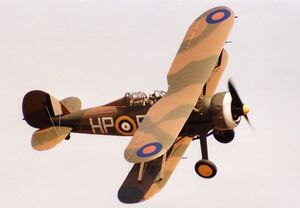
L8032 appearing as ‘N2308′ HP-B, with standard Day Fighter Camouflage. [1]
The Gloster S.S.37 Gladiator was a fighter used by Great Britain and her allies during the early years of World War II.
History[]
Development[]
The Gladiator was first developed by chief designer H. P. Folland and his team as a refined version of the Gloster Gauntlet, and was intended to serve as a late entry in the contest to produce an aircraft to meet Specification F.7/30. This called for a single seat fighter capable of carrying at least four rifle calibre machine guns at 250 mph. [2]
Compared to the Gauntlet, the SS.37 had a wing cellue redesigned as a single bay structure, and was fitted with a pair of cantilever undercarriage legs, each fitted with a single internally spring Dowty wheel. Built as a private venture, the SS.37 prototype was first flown by Flight Lieutenant P. E. G. Sayer, Gloster's chief test pilot, on 12 September 1934. Initially fitted with a Bristol Mercury IV engine, giving the type a maximum speed of 236 mph (380 km/h), the prototype was fitted with a 645 hp (481 Kw) Mercury VIS engine in November 1934, which increased speed to 242 mph (389 km/h). Armed with two Lewis machine guns under the lower wings, and a pair of Vickers Mk III inherited from the Gauntlet mounted in the fuselage, the SS.37 was sent to RAF Martlesham Heath for official evaluation in early 1935.[3]
Submitted to the Air Ministry in June 1935, the SS.37 had Specification F.14/35 written around it, which led to the placing of an order on July 1 for 23 examples, with the type receiving the name Gladiator.[3]
Operational Service[]
[]
The first two RAF units to be equipped with the Gladiator were 72 Squadron at Tangmere, and 3 Squadron at Kenley, who recieved the aircraft in 1937.[4]
Withdrawn from front line operational service with the RAF in 1942, a number of Gladiators were fitted with Lorenz blind flying gear and de-icing equipment, and flown on meteorological duties until 1945.[5]
Other Operators[]
Latvia ordered twenty six Mk Is in 1937, paid for from the proceeds of a public lottery. Shortly afterwards Lithuania followed Latvia's example by purchasing fourteen Mk Is. Four examples were delivered to the Irish Army Air Corps, two were purchased privately as gifts for the Royal Hellenic Air Force[N 1] Additional orders comprised thirty six ordered by China, thirty two for Belgium, thirty seven for Sweden[N 2] and six examples delivered to Norway, [7] which were supplemented by 6 Mk IIs.[6]
The Gladiator also served with Portugal (15 Mk IIs), Finland (30 ex RAF Mk IIs), Egypt (45 Mk IIs, including some MK Is brought up to Mk II standard), Iraq (14 Mk Is and Mk IIs)[N 3] and South Africa (1 Mk I and 11 Mk IIs)[6]
A number of captured examples were operated by the Luftwaffe. These were apparently Mk Is with fixed pitch wooden airscrews, and were employed by Erganszungsgruppe (S) 1 from Langendiebach near Hanau during 1942-3. [N 4]
To have operated the Gladiators at virtually squadron strength, it is likely that the Luftwaffe acquired the type from a limited number of sources in such condition to enable their regular use. In addition, before using a type it would be probable that at least some spares backup would be required, and would also need to have been available. Within Erg.Gr. (S) 1 it would appear that the various glider towing aircraft types were used by each of the four Staffeln within the Gruppe, rather than concentrated into one. Photographic and logbook evidence has identified six aircraft by unit code: NJ+BO (Werke Nr 45829. Egr.Gr. (S) 1 used NJ codes before adopting 1E), 1E+BL, 1E+DK, 1E+JM, 1E+PH and 1E+SH. Four Werke Nos (Wnr) allotted to Gladiators by the Luftwaffe have so far come to light: 45710 (Gloster 9. Crash-landed on 13/06/42, 80% damaged), 45717 (Gloster 5. Crashed at Langendiebach in 03/43), 45826 (Crash-landed near Babenhausen on 27/04/43) and 45829 (Gloster G5 NJ+BO. Crash-landed on 15/04/42, 45% damaged).[8]
References[]
Notes[]
- ↑ Later followed by 17 ex RAF Mk IIs.[6].
- ↑ Followed by an order for eighteen Mk IIs in 1938.[7]
- ↑ Three additional Mk Is intended for Iraq - K8005, K8006 and K8007 - were retained by the RAF, and assigned to 33 Squadron at Mersa Matruh in 1939.[4]
- ↑ Erg.Gr. (S) 1 ('S' for Schlepp - towed) was a training Gruppe giving primary and operational training for assault glider pilots. Training was mainly conducted on the DFS230 glider. For glider towing duties however the unit used a wide variety of types, including German Arado Ar65s and Heinkel He46s, Czech Avia B-534s and the larger Letov S-328 and at least 10 Gladiators, usually described as 'Glosters'.[8]
Sources[]
- ↑ Aeroflight
- ↑ Green, William. Famous Fighters of the Second World War. Purnell Book Services. 1975.. Page 182
- ↑ 3.0 3.1 World Aircraft Information Files Aviation Partwork. Midsummer Books Ltd.File 895 Sheet 5 (A-Z of Aircraft:Gloster E.28/39 (continued) to Gloster Gladiator
- ↑ 4.0 4.1 Green, William - Fighters. 1975. Page 184
- ↑ Green, William - Fighters. 1975. Page 191
- ↑ 6.0 6.1 6.2 Green, William and Gordon Swanborough. Complete Book of Fighters. Salamander Books. 2001. ISBN 1-84065-269-1 Page 247
- ↑ 7.0 7.1 Green, William - Fighters. 1975. Page 185
- ↑ 8.0 8.1 http://surfcity.kund.dalnet.se/gladiator_luftwaffe.htm
| |||||||||||
